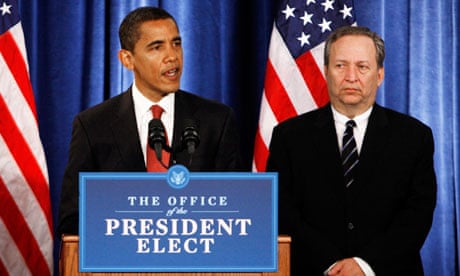Those still wondering why the Obama administration surrendered so quickly on the drive for stimulus and joined the deficit reduction crusade, got the smoking gun in an article by the New Yorker's Washington correspondent Ryan Lizza. Lizza revealed a 57-page memo drafted by Larry Summers, the head of the National Economic Council, in the December of 2008, the month before President Obama was inaugurated.
The memo was striking for two reasons. First, it again showed the economic projections that the administration was looking at when it drafted its stimulus package. These projections proved to be hugely overly optimistic.
They showed that even without stimulus, job loss would peak at around 5 million in the 4th quarter of 2009. They projected that the economy would then begin to add jobs at a fairly rapid pace, regaining all the lost jobs by the end of 2011. In this non-stimulus baseline scenario, the unemployment rate never rose above 9.0%, which it would hit in the winter of 2010.
In reality, the economy had already lost almost 7 million jobs by May of 2009, the month when the first stimulus dollars were going out the door. The job loss didn't stop until February of 2010, at a point where the economy had lost 8.5m jobs. Even with the benefit of the stimulus, the economy is still down by more than 6m jobs from its pre-recession level.
The unemployment rate had already hit 9.4% when the stimulus first started to be felt in May of 2009. It eventually peaked at 10.0% in October of 2009.
In short, the economy was clearly in much worse shape than was implied by the projections that the Obama administration used in crafting its stimulus. In fairness to the Obama administration, these projections were in keeping with the consensus among economists at the time.
The other striking part of this memo is the concern with "bond market vigilantes". The memo discusses the need to focus on the medium-term deficit with the idea of reaching deficit targets by 2014. The highest deficit target listed in the memo for this year was 3.5% of GDP. The memo also includes calculations with a deficit target of 2.5% of GDP, and a balanced budget.
The deficit for the fiscal year that ended last October was 8.5% of GDP. Depending on how the payroll tax debate, the extension of unemployment benefits and a few other issues get resolved, the deficit is not likely to be very much lower in 2012.
This means that getting from a 2012 deficit near 8.0% of GDP to even the 3.5% target for 2014 would require some very serious budget cuts in an economy that will still be suffering from massive unemployment. The difference between a budget deficit of 8.0% of GDP and 3.5% of GDP is equal to almost $700bn annually.
To reach the lower targets that were favored in the memo would require even more heavy lifting. In short, the Obama administration made plans that were quite obviously based on a far too rosy view of the economy. While this favorable assessment was the prevailing view at the end of 2008, what is inexplicable is why the administration never appears to have strayed from its original path – even when it became clear that the economy was doing far worse than projected.
The memo discusses the need to both convince the markets of its seriousness about deficit reduction and to gain the support of "blue dog" Democrats, who were wary of excessive stimulus spending. However, these concerns should have been shelved as the job loss data for January, February and March came in, showing the economy losing close to 700,000 jobs a month.
The administration should have taken this opportunity at the very beginning of Obama's presidency to explain that the economy was actually in worse shape than they had realized and that much more stimulus would be needed. No one could blame the administration for the jobs that were lost in the first two or three months that he was in the White House.
Remarkably, though, the administration did not veer from the course described in this memo in spite of the conflicting economic data. In fact, President Obama began touting the "green shoots of recovery" at a point where the economy was still shedding 400,000 jobs a month.
And he argued for the need to shift the focus to deficit reduction. To show he was serious in this effort, he appointed his deficit commission. One co-chair was former Senator Alan Simpson, who had established a reputation as big-time proponent of cuts to social security and Medicare; the other co-chair was Morgan Stanley director Erskine Bowles.
In short, while the data was crying out for more stimulus, the Obama administration openly embraced the need for deficit reduction, effectively slamming the door on the prospect of further stimulus. The basis for this original sin can be found in that December memo, which, unfortunately, provided the administration's game plan long after it should have been clear that it had been superseded by events.
